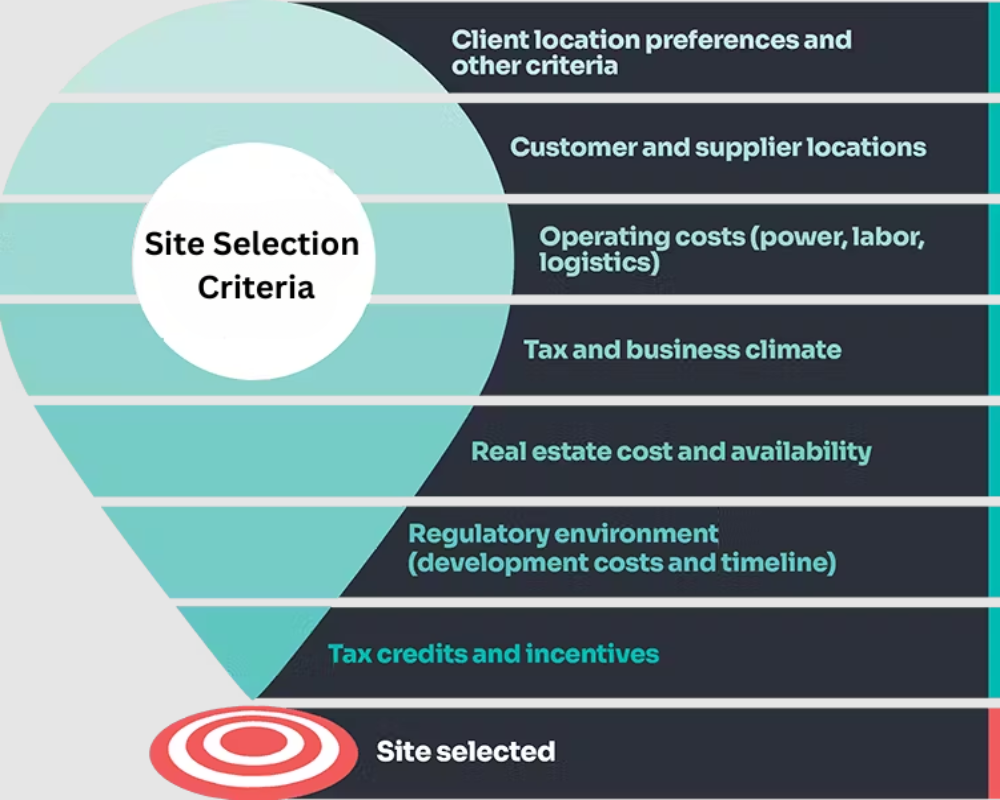Introduction
The selection of a suitable site is a foundational step in the establishment and long-term success of any industrial venture. Site selection influences every aspect of industrial operations, from cost-efficiency and logistics to compliance and future scalability. A well-chosen site aligns with operational needs, regulatory requirements, and strategic growth objectives, while a poor selection can lead to increased expenses, legal hurdles, and operational constraints. Industrial site selection requires a comprehensive evaluation of technical, economic, environmental, and social criteria to ensure the optimal use of resources and sustained industrial productivity.
Proximity to Raw Materials and Suppliers
Industries that depend heavily on raw materials, especially those with high bulk or perishability, benefit from being located close to their sources. A site near raw material suppliers reduces transportation costs, minimizes delays, and ensures a steady and reliable supply chain. This is particularly important for industries such as steel, cement, food processing, and chemicals, where raw materials are required in large quantities or are time-sensitive.
Access to Transportation and Market Connectivity
An ideal industrial site should be well-connected to transportation networks, including highways, railways, ports, and airports. This connectivity is crucial for the inbound movement of raw materials and the outbound distribution of finished products. Sites with multimodal transport options offer flexibility and lower logistics costs. In addition, proximity to major consumer markets or export hubs can enhance market reach and reduce delivery time, especially for industries involved in fast-moving goods or export-oriented manufacturing.
Availability of Skilled and Unskilled Labor
Access to a capable workforce is essential for industrial success. A suitable site should be located near a labor market that can supply both skilled and unskilled workers, depending on the nature of the operation. The availability of vocational training centers, technical institutes, and universities in the region adds value by supporting skill development and reducing recruitment costs. The cost of labor and the quality of life in the surrounding area also influence workforce retention and productivity.
Infrastructure and Utility Support
Basic infrastructure such as electricity, water supply, sewage treatment, telecommunications, and internal roads must be readily available or feasible to develop at the site. The reliability and cost of utilities directly impact operational efficiency and production costs. Industries with high power or water consumption need access to stable and sufficient supplies. Sites within planned industrial estates or economic zones often offer pre-installed infrastructure and support services that reduce initial investment and time to market.
Land Cost and Ownership Clarity
Affordability and ownership clarity are critical factors in industrial site selection. The cost of land must align with the overall project budget and provide value for future expansion. In addition, clear legal titles, absence of disputes, and ease of land acquisition are essential to avoid delays and financial risks. Government-designated industrial zones often offer land on lease or concessional terms, along with streamlined regulatory support.
Regulatory and Zoning Compliance
The selected site must comply with existing zoning laws and land use regulations. It should be located in an area designated for industrial activity to avoid legal complications and community resistance. Industrial zoning ensures compatibility with surrounding land uses, provides development guidelines, and may offer incentives such as tax benefits or fast-track approvals. Non-compliance with zoning can lead to restrictions on operations, environmental liabilities, or revocation of permits.
Environmental Impact and Sustainability
Environmental suitability is a growing concern in site selection, especially for industries that generate emissions, waste, or require large land areas. A thorough environmental impact assessment should be conducted to evaluate the site’s effect on air, water, soil, and biodiversity. Locations that require minimal alteration to the natural environment and offer space for pollution control infrastructure are preferred. Compliance with environmental regulations and public expectations is essential for obtaining permits and maintaining a positive corporate image.
Safety and Risk Management
Safety considerations include evaluating the site’s vulnerability to natural disasters such as floods, earthquakes, or storms, as well as proximity to hazardous operations or sensitive land uses. The availability of emergency services, fire stations, hospitals, and security infrastructure is also important. Industrial sites must be planned with sufficient buffer zones, fire escapes, and containment systems to handle emergencies and ensure worker safety.
Scope for Expansion and Future Development
A forward-looking site selection process considers the long-term growth of the industry. Sites with adequate land for expansion, scalable utility connections, and flexible zoning allow industries to adapt to future market changes, increased production, or diversification. Inflexible or landlocked sites can limit an industry’s ability to respond to growth opportunities or shifts in operational strategy.
Community Relations and Social Acceptance
The relationship between industry and the local community can impact project sustainability. Sites located in regions with supportive local governments and communities are more likely to experience smooth approvals and fewer disruptions. Community engagement, corporate social responsibility initiatives, and transparent communication can foster goodwill and reduce resistance, especially in areas with a history of industrial opposition.
Conclusion
Selecting the right site for an industrial project involves a multifaceted evaluation of physical, economic, legal, social, and environmental factors. Each criterion—from transportation access and labor availability to regulatory compliance and environmental safety—plays a pivotal role in determining the long-term viability of the industrial setup. A thorough, data-driven site selection process not only minimizes risks but also enhances operational efficiency, competitiveness, and adaptability. As industries continue to evolve in response to global challenges and technological advancements, strategic site selection remains a cornerstone of sustainable industrial development.
Hashtags
#SiteSelection #IndustryAnalysis #LocationStrategy #BusinessGrowth #RealEstate #EconomicDevelopment #SiteCriteria #IndustryInsights #MarketResearch #BusinessLocation #StrategicPlanning #InvestmentOpportunities #SiteEvaluation #BusinessStrategy #CommercialRealEstate #SiteAnalysis #LocationIntelligence #IndustryTrends #BusinessDevelopment #SiteSelectionCriteria


